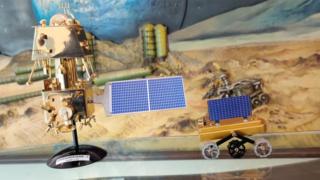- UID
- 20
- Online time
- Hours
- Posts
- Reg time
- 24-8-2017
- Last login
- 1-1-1970
|
|
━━━━━━━━━━━━━━━━━

Getty Images
▼ India's second Moon mission will see the country's space agency attempt to land a rover on the lunar surface on 7 September. Science writer Pallava Bagla explains how it will reach the Moon and why it is significant.
Why is this mission unique?
Costing $150 million, Chandrayaan-2 will carry forward the achievements of its predecessor Chandrayaan-1 which was launched in 2008 and discovered the presence of water molecules on the parched lunar surface.
Chandrayaan-2 is a three-in-one mission comprising an orbiter, a lander named Vikram and a six-wheeled rover named Pragyaan.
It was launched on 22 July, a week after its scheduled blast-off, which was halted due to a technical snag.
It entered the Moon's orbit nearly a month later in a tricky operation, completing a series of manoeuvres before its lander was cut loose on 2 September.
Now, on 7 September, a little after midnight India local time (1800 GMT), the lander which contains the rover will be sent hurtling down to the lunar surface where it is expected to make a landing near the South Pole of the Moon.
The last 15 minutes of the mission, when the Vikram lander will attempt to autonomously guide itself down to the lunar surface with no support from ground control, has been described as "15 minutes of terror" by the head of the Indian Space Research Organisation (Isro), Dr K Sivan.
If India does succeed in touching down with the Vikram lander intact, it will become the fourth country to do so after the US, Russia and China.
More importantly for Indians, it will mean the nation's flag will reach the Moon intact.
How will it land on the Moon?
The Moon may be Earth's closest neighbour, but landing on it is a very tricky operation.
It has no atmosphere worthy of the name, which means parachutes cannot be used to slow the lander's descent to the surface. The only option therefore is to go in for what is called a "powered descent".
This means that the velocity of the lander is steadily reduced with its own rocket engines.
The lander will be moving horizontally across the surface of the Moon as it descends. The rocket engines must bring that horizontal movement to a stop whilst at the same time controlling the rate of descent to near zero just before the moment of touchdown.
This is known as a "soft landing".
Before the final approach, both the orbiter and lander would have surveyed the Moon to find a "sweet spot" with no craters and boulders where it can land.
If the lander does not function properly it could crash land on the Moon surface, like its predecessor Chandrayaan-1 - though this was an intentional crash landing as in 2008 India had not yet mastered how to perform a soft landing.
Either way, once the landing happens and the lunar dust that may have been kicked up settles, the ramp opens up and the rover is very gently wheeled out.
The rover will then "Moon walk" at the princely speed of one centimetre per minute. It can travel a maximum of 500m (1,640ft) from the lander.
Both the lander and rover are powered with solar batteries and carry three instruments apiece.
What will the lander do? (▪ ▪ ▪)
► Please, continue reading this article here: Source |
|